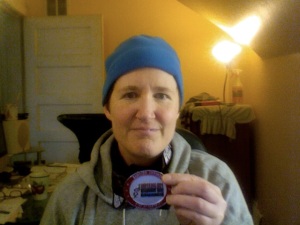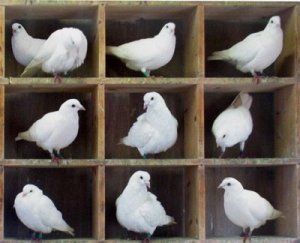 Lately, I’ve been seeing a lot of articles touting the notion that “everyone” should learn how to program computers. One article goes so far as to endorse teaching coding in the 6th grade, and possibly sooner.
Lately, I’ve been seeing a lot of articles touting the notion that “everyone” should learn how to program computers. One article goes so far as to endorse teaching coding in the 6th grade, and possibly sooner.
Whenever I read these articles, my first thought is that I don’t know why anyone in the IT industry would want to teach “everyone” to code. The simple economic concept of aggregate supply/aggregate demand dictates that once “everyone” learns a particular skill, that skill will plummet in value. If “everyone” learned how to code, people who can pound out code as fast as a popcorn machine spits out kernels would be paid $7.00/hour…when they could obtain programming work at all, because the Pigeonhole Principle would also kick in.
Although, realistically, an America where “everyone” knows how to build their own copy of Microsoft Office isn’t going to happen until most people actually know how to use the existing version of Office. Check out this article in today’s New York Times about how many graduates of the top business schools in the nation are illiterate in Microsoft Excel and PowerPoint:
Newly minted university graduates who have landed coveted jobs on Wall Street may have impressive résumés and sought-after references. But often, nuts-and-bolts skills like spreadsheet building and database extraction are not part of university curriculums.
When millions of dollars can be won or lost on one calculation, firms are finding it essential that their new hires can tell the difference between a pivot table and a header row….
…
“I just want someone who can really use Excel and PowerPoint,” said one senior loan syndication banker at a European bank, describing his recent interviews of newly minted M.B.A.’s in New York.
Keep in mind that these graduates are Millennials who grew up with this technology. I grew up with typewriters, and I know how to use Excel, including advanced functions like pivot tables and if-then statements. I never took a $3,000.00 class to learn Microsoft Office. I never took any class. I learned how to use Office on my own. I never was able to grasp enough C and Java (or whatever language I would need) to build my own version of Office, but I’m a power user of the one that Microsoft built.
I have personal experience with this phenomenon. While attending Temple University as an older student, I met throngs of Millennials who couldn’t format a simple Word document or use the SUM function in Excel. I’ve encountered the same thing in my MBA program at Wilmington University. I took a statistics class where several students failed because they had no idea how to use Excel…and no intention of learning it.
It seems to me that before we talk about teaching 6th graders how to code, we should first teach them how to format a Word document or set up a basic Excel spreadsheet. Basic English and critical thinking skills would be nice, too, but that’s a subject for another blog.
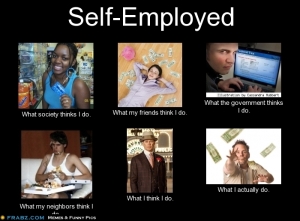 If you haven’t held a “traditional” job in years and feel like the odd one out, take heart: a study predicts that by 2020, the self-employed will outnumber workers who labor for other people.
If you haven’t held a “traditional” job in years and feel like the odd one out, take heart: a study predicts that by 2020, the self-employed will outnumber workers who labor for other people.
My husband and I are ahead of the curve. With the exception of a brief W2 temp job I held at the end of 2011–and being as it was strictly temporary, I don’t consider it a “traditional” job–neither one of us has held a job since 2006. However, we have continuously worked during that time.
Self-employment–regardless of whether you’re doing network marketing–bears little resemblance to working for other people. W2 employees get a check for hours worked on a regular schedule. The self-employed put far more hours into their businesses than they ever get paid for. There is no such thing as making “fast easy money from the comfort of your home, in your pajamas.” The money never comes easy. It takes hard work, and a lot of it. We eat what we kill.
Our economy is quickly moving away from traditional jobs and toward independent workers. Arguably, the best option for most long-term unemployed Americans is self-employment. Many people argue that the biggest barrier to starting a business is money. I disagree. With the advent of the Internet, there are many businesses that can be launched with little or no money. The biggest barrier, I think, is breaking out of the traditional job mindset and teaching yourself to think like an entrepreneur, not an employee.
Yesterday, my husband and I ran our first half marathons in Philadelphia.
Because we live in northern Delaware, we decided to drive into the city. Problem was, I’m not used to driving into the city. I’m used to getting on a train and then stepping out of it in the city. Unfortunately, the SEPTA Regional Rail that serves our area didn’t run at the ungodly early hour we needed to leave at, so I was stuck driving. I ended up getting off the wrong exit of the Vine Street Expressway and having a panic attack over the notion of missing the race because I got lost. We finally managed to find a cop, who got me turned in the correct direction.
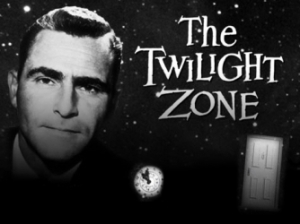 We ended up parking at the garage for the Community College of Philadelphia. It really should be called the Twilight Zone Garage. We parked on Level 6 (how appropriate), then made our way down the stairs…which came to a dead stop at Level 2. We wandered around Level 2 for several minutes, searching for an exit, going around in circles. I was reminded of the Doctor Who episode where the Doctor, Amy and Rory were trapped in a hotel with no exit. Meanwhile, we were supposed to be at the race at 6:00 a.m., and it was approaching 6:20. Finally, we heard voices and rushed toward them; we’d found a group of people who knew how to get out of this garage! After following them to the carefully concealed exit, we decided to follow them to the race start. I had no idea how to get there from where I was. My logic was that if those people could find their way out of the Twilight Zone Garage, they’d certainly know how to get to the race.
We ended up parking at the garage for the Community College of Philadelphia. It really should be called the Twilight Zone Garage. We parked on Level 6 (how appropriate), then made our way down the stairs…which came to a dead stop at Level 2. We wandered around Level 2 for several minutes, searching for an exit, going around in circles. I was reminded of the Doctor Who episode where the Doctor, Amy and Rory were trapped in a hotel with no exit. Meanwhile, we were supposed to be at the race at 6:00 a.m., and it was approaching 6:20. Finally, we heard voices and rushed toward them; we’d found a group of people who knew how to get out of this garage! After following them to the carefully concealed exit, we decided to follow them to the race start. I had no idea how to get there from where I was. My logic was that if those people could find their way out of the Twilight Zone Garage, they’d certainly know how to get to the race.
When we arrived at the race site, we encountered what is my only complaint about the event itself: a lack of signage and volunteers directing traffic. We had to wander around to find the gear check, then wander around some more in search of our corral. When we couldn’t find our corral, we decided to first make use of the Porta Potties. There was a very long line, but we were in the last corral, so we figured we’d have time. The pre-race festivities began while we were standing in line, with a clear view of the old PSFS building displaying the time and temperature: a crisp 38 degrees F as we approached 7:00 a.m. Normally, I despise cold weather, but for running purposes, 38 degrees is a good thing.
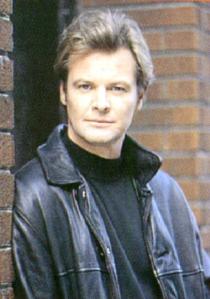 After we finally got to use the Porta Potties, we searched for our corral again. By this time, the race was beginning. At 6:59:50, a countdown began to the start, and I immediately had Nick Knight flashbacks to the times I’d spent New Year’s Eve in New York. This was intensified by the people ringing cowbells on the sidelines (New Year’s Eve in New York is full of people making noise), as well as the fact that there were two corrals of runners who’d been granted entry into our race after theirs had been cancelled. Even as we continued a desperate search for our corral, I screamed along with the countdown, feeling like I was back there. (Um, it’s not really normal to have flashbacks that are that clear, is it? Oh well.) My husband finally found the corral.
After we finally got to use the Porta Potties, we searched for our corral again. By this time, the race was beginning. At 6:59:50, a countdown began to the start, and I immediately had Nick Knight flashbacks to the times I’d spent New Year’s Eve in New York. This was intensified by the people ringing cowbells on the sidelines (New Year’s Eve in New York is full of people making noise), as well as the fact that there were two corrals of runners who’d been granted entry into our race after theirs had been cancelled. Even as we continued a desperate search for our corral, I screamed along with the countdown, feeling like I was back there. (Um, it’s not really normal to have flashbacks that are that clear, is it? Oh well.) My husband finally found the corral.
The wife of one of the runners in our corral had come to spectate, along with the couple’s dog. I patted and played with the dog as we waited to move forward. Because we were in the back, we didn’t cross the start line until 7:33 a.m. I screamed, “BRING IT!” as I began my race, and I periodically yelled it at the spectators throughout the race, making the P90X sign with my arms. I’m sure a lot of them had no idea what I was talking about.
 My training runs had been conducted on running tracks: a quarter-mile track behind the old Claymont High School (which I’d nicknamed “The Swamp” because that’s what it felt like in the summer) and a serene 1-1/8 mile track at Bellevue State Park. I feared I’d be overwhelmed by running in an urban environment, but I didn’t feel out of my element at all. It was nice to, as my husband put it, not run in circles and see the same thing over and over.
My training runs had been conducted on running tracks: a quarter-mile track behind the old Claymont High School (which I’d nicknamed “The Swamp” because that’s what it felt like in the summer) and a serene 1-1/8 mile track at Bellevue State Park. I feared I’d be overwhelmed by running in an urban environment, but I didn’t feel out of my element at all. It was nice to, as my husband put it, not run in circles and see the same thing over and over.
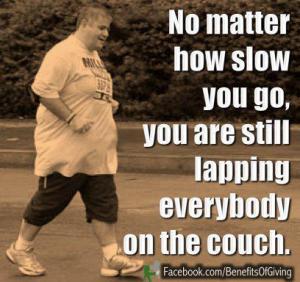 My husband shot ahead of me and out of sight at about Mile 1/8. I spent the rest of my run alongside strangers, many of whom inspired me without realizing it. There were obese people, some of whom had committed to the full 26.2. There were people who appeared to be in their 60’s and 70’s. There were people who were obviously running with injuries, including one guy who went very slow and kept clutching his leg, and a lady who I overheard telling her friend that she’d probably have to walk because her ankle hurt when she tried to run. There were people who had signs on their shirts saying that they were cancer survivors, as well as people running in honor of loved ones who were battling a serious illness…or who’d lost their battles. There were the NYC runners, doing their race in a different city, two weeks late, but finishing what they’d started and raising money for victims of the hurricane. And there was the lady with the shirt that said, “Today is my 55th birthday, and I’ll run 13.1 miles if I want to!” I told her how much I liked her shirt and admired her determination. There were people who had to walk most of the way, but who kept going.
My husband shot ahead of me and out of sight at about Mile 1/8. I spent the rest of my run alongside strangers, many of whom inspired me without realizing it. There were obese people, some of whom had committed to the full 26.2. There were people who appeared to be in their 60’s and 70’s. There were people who were obviously running with injuries, including one guy who went very slow and kept clutching his leg, and a lady who I overheard telling her friend that she’d probably have to walk because her ankle hurt when she tried to run. There were people who had signs on their shirts saying that they were cancer survivors, as well as people running in honor of loved ones who were battling a serious illness…or who’d lost their battles. There were the NYC runners, doing their race in a different city, two weeks late, but finishing what they’d started and raising money for victims of the hurricane. And there was the lady with the shirt that said, “Today is my 55th birthday, and I’ll run 13.1 miles if I want to!” I told her how much I liked her shirt and admired her determination. There were people who had to walk most of the way, but who kept going.
The volunteers and spectators were fantastic. We Philadelphians love our sports, and many of the people in the neighborhoods we ran through turned the marathon into a block party, bringing out their lawn chairs and cheering on the runners as fervently as they would our pro sports teams. I gave a lot of high-fives as I moved along the course. My favorite group might have been the Drexel frat boys, who were handing out beer. I laughed and told them, “After, not during!” Inspirational and funny signs were abundant. My favorite was near Mile 4 of the race: “If you were Paul Ryan, you’d have been here an hour ago!”
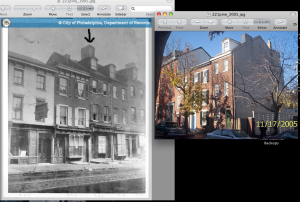 My husband’s game plan was simple: run from water station to water station. For me, the race was a religious experience. I dedicated each mile to a person. The first four were for my great aunt and her husband and two children, the latter three who’d died before I was born. Mary kept living in their home in Society Hill until she died herself in 2005: over 60 years in the same house. As I ran past the intersection at 2nd & South, I looked down the street, trying to see the house at 2nd & Pine. It was just out of my viewing range, but I could feel the spirits of its inhabitants carrying me through that part of the race. I looked toward it again as we ran up 6th and crossed Pine again.
My husband’s game plan was simple: run from water station to water station. For me, the race was a religious experience. I dedicated each mile to a person. The first four were for my great aunt and her husband and two children, the latter three who’d died before I was born. Mary kept living in their home in Society Hill until she died herself in 2005: over 60 years in the same house. As I ran past the intersection at 2nd & South, I looked down the street, trying to see the house at 2nd & Pine. It was just out of my viewing range, but I could feel the spirits of its inhabitants carrying me through that part of the race. I looked toward it again as we ran up 6th and crossed Pine again.
Throughout my training, I’d been fighting plantar fasciitis, posterior tibial tendinitis, and Achilles tendinitis in my right foot and ankle. To my horror, these problems had been acute in the 4-5 days leading up to the race, and I did feel them at the start line. My foot and ankle felt good until about Mile 8, when it decided to be a screaming bitch on a bitch boat. But I was determined to finish…after all, each mile wasn’t just for me, it was in honor of someone who had died (and the last 3.1 were in honor of someone who was recently diagnosed with terminal pancreatic cancer). For my last 5.1 miles, whenever my ankle felt like it would explode or my Achilles snap, I slowed to a walk. I never came to a dead stop, I just walked, for as long as I needed to. Then I ran again as long as I could. Then I slowed again when I had to. I asked the people I was running for to help me finish this, to run with me those last few miles. The crowd of living people cheering us on helped me greatly as well.
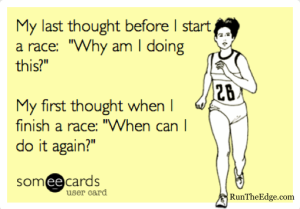 As we approached Mile 12, I told a fellow runner, “I can see 13.1 from my window!” In training, I had completed two 12-milers on this bad foot and ankle; I knew I could manage another mile and change. I was going to cross the finish line even if I had to do it while hopping on my good leg. Surprisingly, I managed to run most of that last stretch. I ran across the finish line, where my husband had been waiting for over 25 minutes.
As we approached Mile 12, I told a fellow runner, “I can see 13.1 from my window!” In training, I had completed two 12-milers on this bad foot and ankle; I knew I could manage another mile and change. I was going to cross the finish line even if I had to do it while hopping on my good leg. Surprisingly, I managed to run most of that last stretch. I ran across the finish line, where my husband had been waiting for over 25 minutes.
My finish time ended up being 3:07:56, or 14:21/min/mile. While in training, I’d averaged between 14:00 and 14:30/min/mile on my long runs, when I didn’t walk anywhere near as much, and when I didn’t lose about 5 minutes to a bathroom break. I must have really flown during my first 8 miles.
I’m going to take two weeks off, then attempt to train to do 26.2 in Los Angeles on St. Patrick’s Day. I will make 26.2, even if I have to wait until next year’s marathon in Philly to make it.
